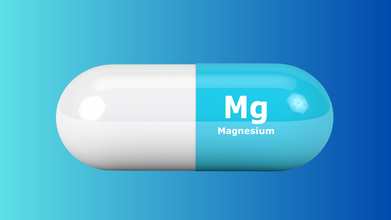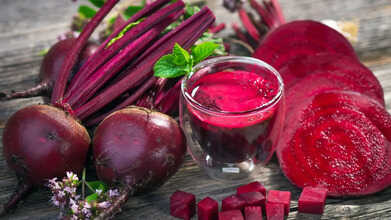- Health Conditions A-Z
- Health & Wellness
- Nutrition
- Fitness
- Health News
- Ayurveda
- Videos
- Medicine A-Z
- Parenting
- Web Stories
Oatmeal Drink For Weight Loss: Can Viral ‘Oatzempic’ Really Help You Shed Pounds?

Can Oatzempic Really Help You Lose Weight?
After struggling with weight loss, Aastha stumbled upon the Oatzempic drink on TikTok. Intrigued, she blended oats, lime juice, and water into a refreshing smoothie. Surprisingly, it kept her full longer! It became her go-to breakfast, transforming her mornings and reigniting my passion for healthy living.
The quest for effective weight loss solutions has led many to explore new options, particularly with the rising popularity of weight loss medications like Ozempic and Wegovy. As a result, health-conscious individuals are constantly on the lookout for innovative and affordable alternatives. Enter "Oatzempic," a drink making waves on TikTok that claims to help users shed pounds while offering the nutritional benefits of oats.
This article delves into the hype surrounding Oatzempic, the health benefits of oats, and provides delicious recipes to incorporate this powerhouse ingredient into your diet.
Oatzempic, a clever combination of “oats” and “Ozempic,” has emerged as a trending health tonic among TikTok users. This simple drink comprises just three ingredients: oats, water, and lime juice. Videos of the drink are flooding social media, with users boasting about its weight loss potential.
One TikTok creator's “Oatzempic Challenge” video garnered over 2.7 million views, highlighting the drink's popularity. The hashtag #Oatzempic now boasts more than 1,100 posts, indicating a growing community eager to share experiences.
How to Make Oatzempic?
While individual recipes may vary, the basic preparation of Oatzempic typically includes:
- 1 cup water
- 1/2 cup instant oats
- Juice from half a lime
To prepare, combine the ingredients in a blender and blend until smooth. This concoction is touted as a healthy alternative to more processed weight loss solutions, but experts caution against making exaggerated claims regarding its efficacy.
Can Oatzempic Really Help You Lose Weight?
The claim that Oatzempic can yield dramatic weight loss results is met with skepticism from health professionals. While oats are beneficial for weight management due to their high fiber content, simply drinking Oatzempic is unlikely to produce significant results if other lifestyle habits remain unchanged.
Oats are rich in fiber, with one cup containing approximately 8 grams. This fiber helps to regulate appetite, promoting a feeling of fullness and reducing overall caloric intake. The soluble fiber, beta-glucan, found in oats absorbs water, forms a gel-like consistency, and slows digestion. This process not only helps with satiety but also stabilizes blood sugar levels.
However, it’s essential to understand that the effects of Oatzempic are not equivalent to those of prescription weight loss medications, which work through entirely different mechanisms.
Health Benefits of Oats
Oats are a nutritional powerhouse packed with various health benefits that contribute to weight loss and overall well-being:
Nutritional Profile
Oats are loaded with dietary fiber, particularly beta-glucan, which is known for its ability to lower cholesterol levels. They also provide protein, vitamins, and essential minerals such as manganese, phosphorus, magnesium, and iron.
Satiety
The fiber content in oats keeps you feeling full longer, helping control appetite and reduce calorie consumption.
Metabolism Boost
The rich nutrient profile of oats offers a sustained energy release, which can enhance metabolism and aid in weight loss.
Smoothies are an excellent way to incorporate oats into your diet. Oats smoothies are easy to prepare, delicious, and packed with nutrients that can help you achieve your weight loss goals. Below is a recipe for a nutritious oats smoothie along with variations to suit your taste.
Oats Drink Recipe For Weight Loss
Ingredients:
- 1/2 cup rolled oats
- 1 cup almond milk
- 1 banana
- 1/2 cup Greek yogurt
- 1 tablespoon chia seeds
- 1/2 cup frozen berries
- 1 teaspoon honey (optional)
- 1 handful of spinach (optional)
Method:
1. Add the rolled oats and almond milk to the blender. Allow it to sit for a few minutes to soften the oats.
2. Add the banana, Greek yogurt, chia seeds, frozen berries, and spinach to the blender.
3. Blend on high until smooth and creamy.
4. Taste and add honey if desired for extra sweetness.
5. Pour into a glass and enjoy immediately.
Variations of Oats Smoothies
1. Green Oats Smoothie
Combine oats with spinach, kale, green apple, and coconut water for a refreshing green drink.
2. Berry Oats Smoothie
Blend oats with a mix of your favorite berries, such as strawberries, blueberries, and raspberries, along with a splash of almond milk.
3. Tropical Oats Smoothie
Blend oats with pineapple, mango, and coconut milk for a taste of the tropics.
4. Chocolate Oats Smoothie
Satisfy your sweet tooth with a smoothie made from oats, cocoa powder, banana, and almond milk.
Tips for Making the Best Oats Smoothie
Blending Tips: Start by blending the oats with the liquid to achieve a smooth texture before adding other ingredients.
Adjusting Sweetness: If your smoothie isn’t sweet enough, incorporate natural sweeteners like honey or maple syrup.
Meal Prep: You can prepare your oats smoothie the night before and store it in an airtight container in the fridge. Shake well before consuming.
How Oats Smoothies Aid in Weight Loss
Oats smoothies are low in calories yet nutrient-dense, making them ideal for weight management. Their high fiber content promotes fullness, curbing unnecessary snacking. Additionally, the low glycemic index of oats helps regulate blood sugar levels, preventing energy crashes.
Incorporate oats smoothies into your diet as a breakfast option or post-workout snack to reap their benefits. They can serve as meal replacements or snacks depending on the ingredients used.
Common Mistakes to Avoid
1. Be cautious about sweeteners that can diminish the health benefits of your smoothie.
2. Avoid instant oats as they are often highly processed and less nutritious.
3. Ensure a balance of carbohydrates, protein, and healthy fats in your smoothie for sustained energy.
Oats and their derivatives, such as Oatzempic and oats smoothies, are gaining traction as effective tools for weight loss and healthy eating.
While they offer numerous health benefits, it is vital to maintain a balanced diet and healthy lifestyle to achieve lasting results. With a little creativity, incorporating oats into your meals can be both delicious and beneficial for your weight loss journey.
Why Magnesium Matters More Than You Think

Credits: Canva
Magnesium supplements are everywhere. Whether you see it on pharmacy shelves or wellness blogs and social media where influencers who swear by them. You’ve probably heard someone claim that a daily magnesium tablet can help you sleep better, ease muscle cramps, or boost your mood. But do you actually need one, or is this just another wellness trend gone too far?
What Is Magnesium and Why Do We Need It?
Magnesium is an essential mineral that plays a crucial role in over 300 biochemical reactions in the body. It helps regulate muscle and nerve function, supports a healthy immune system, builds protein, maintains blood sugar and blood pressure levels, and aids in energy production.
Because the body doesn’t produce magnesium on its own, it must come from external sources such as food or supplements. The recommended daily intake varies: 310–420 mg for adults and 30–410 mg for children, depending on age and sex.
The good news? A balanced diet can easily meet these requirements. Magnesium-rich foods include nuts and seeds, leafy green vegetables, legumes, seafood, whole grains, and meat. Even dark chocolate can help, 100 grams of dark chocolate contains around 146 mg of magnesium.
Who Is at Risk of Magnesium Deficiency?
Most people get enough magnesium from food, but certain groups are more vulnerable to deficiency. These include people with gastrointestinal disorders such as Crohn’s disease or coeliac disease, those with type 2 diabetes, people who consume excessive alcohol, and older adults.
If you’re low on magnesium, you might notice symptoms such as muscle twitches, spasms, fatigue, low appetite, nausea, or an irregular heartbeat. However, the only way to confirm a deficiency is through a blood test prescribed by your doctor, which, in most cases, is covered by Medicare.
Can Magnesium Supplements Really Help?
Magnesium supplements are often promoted as a solution for muscle cramps, migraines, and insomnia. But do they actually work?
While magnesium deficiency can lead to cramps, most cases of muscle cramps are not due to low magnesium. Research shows limited evidence that supplements prevent cramps, especially in older adults.
The link between magnesium and better sleep is also unclear. Some studies found it helped people fall asleep faster, while others found no significant difference.
When it comes to migraines, evidence is stronger. Studies suggest that taking 122–600 mg of magnesium daily for 4–24 weeks may reduce the frequency and severity of migraines in some people.
Are Magnesium Supplements Safe?
In general, magnesium supplements are safe when taken in the recommended amounts. However, too much can lead to nausea, abdominal cramps, and diarrhea, because magnesium draws water into the intestines.
Taking extremely large doses (around 5,000 mg daily) can cause magnesium toxicity, which is dangerous. Always check with your doctor before starting supplements, especially if you take other medications.
Different Forms and What to Watch Out For
Magnesium is available in tablets, powders, and even topical forms like creams and bath salts. While these skin-based products may raise magnesium levels slightly, they’re less effective than oral supplements or food sources.
When buying supplements, check the label carefully. Most tablets contain 150–350 mg of magnesium, but formulations vary widely. Some also include additional nutrients like vitamins B6, C, or D, and minerals like calcium or manganese.
Be cautious with vitamin B6, high intake can cause nerve damage over time. If you already take a multivitamin containing B6, avoid magnesium supplements that also include it.
Think Your Milk Is Fresh? Simple Ways To Spot Adulteration At Home

Credits: Canva
Milk is one of the most common items found in every household and is considered a wholesome food packed with calcium, protein, and vitamin D.
It plays an important role in maintaining strong bones, building muscles, and supporting overall health. Because of its nutritional richness, milk is often called a complete food. However, it is essential to ensure that the milk you consume is pure and free from adulteration. Contaminated or diluted milk can lose its nutritional value and even harm your health. Fortunately, there are simple methods you can try at home to find out whether your milk is pure or adulterated.
What Is Milk Adulteration?
Food adulteration is the intentional act of reducing the quality of food by mixing or replacing it with inferior substances, or by removing essential components. The same applies to milk. While contamination of food can happen accidentally during storage, transport, or distribution, adulteration is done deliberately for profit.
Milk adulteration involves adding materials such as water, urea, detergent, or other chemicals to increase volume or extend shelf life. This practice reduces the nutritional value and can pose serious health risks to consumers.
How To Check Milk Adulteration at Home
There are a few simple ways to check for adulteration using common items at home:
- Water Test: Pour a small amount of milk onto a slanted surface. Pure milk flows slowly, leaving a white trail, while milk mixed with water flows quickly and leaves little or no mark.
- Detergent Test: Shake equal parts of milk and water. Pure milk forms a light foam, whereas adulterated milk creates thick, soapy froth.
- Starch Test: Add a few drops of iodine solution to the milk. If it turns blue, starch has been added.
- Urea Test: Mix a small amount of milk with soybean powder and dip red litmus paper into it. If the paper turns blue, it indicates the presence of urea.
What Happens When You Consume Adulterated Milk
Regularly drinking adulterated milk can cause several health issues from short-term stomach discomfort to severe, long-term illnesses. The exact effects depend on what substance has been added, ranging from diluted water to harmful chemicals.
Immediate Health Effects
- Digestive problems: Contaminants like urea, detergent, or unclean water can cause nausea, vomiting, diarrhea, and stomach cramps.
- Irritation and burning: Strong alkaline substances such as caustic soda may burn the mouth, throat, and digestive tract, damaging body tissues.
- Allergic reactions: Some chemical additives and impurities can trigger allergies, leading to rashes, itching, or breathing difficulty.
Long-Term Health Consequences
- Kidney damage: Chemicals like urea overwork the kidneys, increasing the risk of long-term damage or kidney failure.
- Liver problems: Preservatives such as formalin (formaldehyde) used to prolong milk’s freshness can harm the liver over time.
- Cancer risk: Long exposure to toxic compounds, including formalin and certain pesticides, has been linked to cancer.
- Heart disease: Artificial fats or vegetable oils added to milk can raise bad cholesterol, contributing to heart problems.
- Hormonal imbalance: Cattle injected with hormones like oxytocin can pass traces into milk, disrupting natural hormone levels in humans.
- Weakened immunity: Consuming impure milk regularly can weaken the immune system, making you more prone to infections.
- Nutritional deficiency: When milk is diluted or its nutrients are replaced with cheaper additives, it loses its health benefits. This is especially harmful for children, as it can affect their growth and development.
THIS Common Vegetable Juice Can Help Lower Your Blood Pressure Naturally

Credits: Canva
A common vegetable has been found to help reduce blood pressure in older adults, according to a new study. Beetroot juice can lower blood pressure in people aged 60 and above by targeting certain potentially harmful bacteria in the mouth. Researchers at the University of Exeter studied how younger and older adults responded to beetroot juice, which is rich in dietary nitrates. These nitrates are converted by the body into nitric oxide, a compound that relaxes and widens blood vessels, helping to lower blood pressure.
How the Study Tested Beetroot Juice on Younger and Older Adults
The study included 39 adults under the age of 30 and 36 adults in their 60s and 70s. For two weeks, each group received shots of beetroot juice. After a two-week break, during which participants used antiseptic mouthwash daily, they were given a placebo juice without nitrates for another two weeks.
Researchers analyzed the bacteria in participants’ mouths using gene sequencing. In both groups, the oral microbiome—the community of microorganisms in the mouth—changed after drinking nitrate-rich juice, though the effects were different depending on age. In older adults, there was a reduction in common bacteria that can sometimes cause infections and an increase in bacteria that support health. The older participants also showed lower blood pressure after two weeks of drinking the nitrate-rich juice.
Professor Andy Jones of the University of Exeter said, “This study shows that nitrate-rich foods can change the oral microbiome in ways that may reduce inflammation and lower blood pressure in older adults. This opens the door for larger studies to examine how lifestyle factors and biological sex affect responses to dietary nitrate supplements.”
Can A Person Drink Beet Juice While Taking Blood Pressure Medication?
It may be possible to drink beet juice while taking blood pressure medications. However, it’s important to consult a doctor before making any changes to a treatment plan for high blood pressure.
A doctor can advise whether combining beet juice with blood pressure medication could lower blood pressure too much. If this happens, a person may experience symptoms such as:
- Dizziness or lightheadedness
- Blurry vision
- Fainting
- Confusion
- Weakness or tiredness
- Headache
- Back or neck pain
- Heart palpitations
- Nausea
Low blood pressure (hypotension) can be serious. If someone experiences severe symptoms that do not improve when sitting or lying down, they should seek immediate medical attention.
Does Eating Beets Lower Blood Pressure?
Eating beets may help reduce blood pressure, but most research has focused on beet juice rather than whole beets.
Currently, there isn’t enough scientific evidence to confirm that eating beets has the same effect as drinking beet juice.
If someone wants to explore dietary changes to manage their blood pressure, it’s best to consult a doctor before making adjustments.
© 2024 Bennett, Coleman & Company Limited

